Related Research Articles

Punch, or The London Charivari was a British weekly magazine of humour and satire established in 1841 by Henry Mayhew and wood-engraver Ebenezer Landells. Historically, it was most influential in the 1840s and 1850s, when it helped to coin the term "cartoon" in its modern sense as a humorous illustration. From 1850, John Tenniel was the chief cartoon artist at the magazine for over 50 years.

Puck was the first successful humor magazine in the United States of colorful cartoons, caricatures and political satire of the issues of the day. It was founded in 1876 as a German-language publication by Joseph Keppler, an Austrian immigrant cartoonist. Puck's first English-language edition was published in 1877, covering issues like New York City's Tammany Hall, presidential politics, and social issues of the late 19th century to the early 20th century.

Caran d'Ache was the pseudonym of the 19th century French satirist and political cartoonist Emmanuel Poiré. The pseudonym comes from Russian: карандаш, romanized: karandash meaning "pencil" in Turkic languages. While his first work glorified the Napoleonic era, he went on to create "stories without words" and as a contributor to newspapers such as the Le Figaro, he is sometimes hailed as one of the precursors of comic strips. The Swiss art products company Caran d'Ache is named after him.

Albert Guillaume was a French painter and caricaturist.
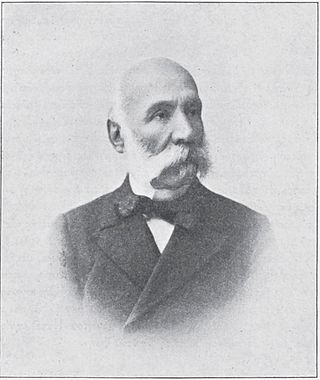
Theodoros Deligiannis was a Greek politician, minister and member of the Greek Parliament, who served as Prime Minister of Greece five times from 1885 until his assassination.
Charlie Hebdo is a French satirical weekly magazine, featuring cartoons, reports, polemics, and jokes. The publication has been described as anti-racist, sceptical, secular, libertarian and within the tradition of left-wing radicalism, publishing articles about the far-right, religion, politics and culture.
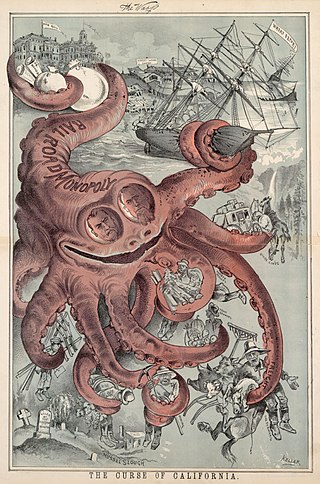
The Wasp, also known as The Illustrated Wasp, The San Francisco Illustrated Wasp, The Wasp News-Letter and the San Francisco News- Letter Wasp, was an American weekly satirical magazine based in San Francisco. Founded in 1876, it closed in 1941, the name of the magazine having been changed several times in the interim.
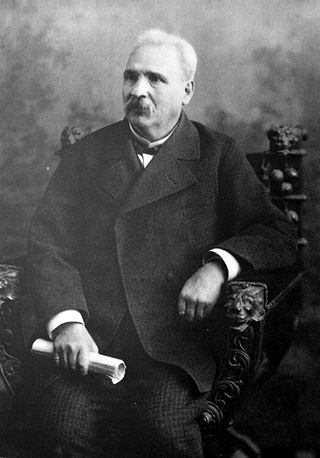
Petko Rachov Slaveykov was a Bulgarian poet, publicist, politician and folklorist.

The Vilayet of Salonica was a first-level administrative division (vilayet) of the Ottoman Empire from 1867 to 1912. In the late 19th century it reportedly had an area of 12,950 square miles (33,500 km2).

The postal history of Turkey and its predecessor state, the Ottoman Empire, dates to the 18th century when foreign countries maintained courier services through their consular offices in the Empire. Although delayed in the development of its own postal service, in 1863 the Ottoman Empire became the second independent country in Asia to issue adhesive postage stamps, and in 1875, it became a founding member of the General Postal Union, soon to become the Universal Postal Union. The Ottoman Empire became the Republic of Turkey in 1923, and in the following years, its postal service became more modernized and efficient and its postage stamps expertly designed and manufactured.

Fatma Aliye Topuz, often known simply as Fatma Aliye or Fatma Aliye Hanım, was a Turkish novelist, columnist, essayist, women's rights activist and humanitarian. Although there was an earlier published novel by the Turkish female author Zafer Hanım in 1877, since that one remained her only novel, Fatma Aliye Hanım with her five novels is credited by literary circles as the first female novelist in Turkish literature and the Islamic world.

Theodoros Kasapis (1835–1897) was an Ottoman Greek newspaper editor and educator.

Diyojen (“Diogenes“) was the first Ottoman satirical magazine of the Ottoman Empire. The first issue was published in Istanbul on 24 November 1870 by the satirist Teodor Kasap (1835-1905). The caricatures published in Diyojen appeared without signs of the artists. It came out weekly in three year's issues and was banned for good in 1873 after 183 numbers. Apart from satirical pieces, the magazine became known for its caricatures and the translation of French literature. Kasap, who also worked as journalist and playwright, published other satirical magazines after the ban. In Hayal, which existed from 1873 until 1877, he among other things used caricatures and satirical articles to criticize the arbitrary press law.
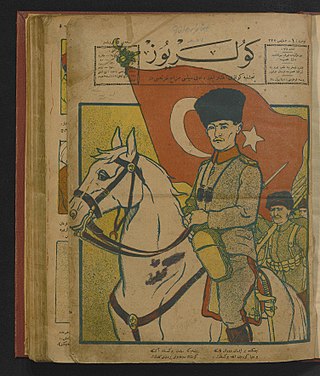
The Ottoman Turkish satirical magazine Güleryüz appeared in Istanbul weekly from 1921 to 1923 with a total of 122 editions. Its publisher and founder, Sedat Simavi (1896-1952), was a Turkish journalist, political cartoonist, writer and film director. He is also known as co-founder of the Turkish Association of Journalists in 1946 and the daily newspaper Hürriyet (1948).

The Ottoman satirical magazine Karagöz was published from 1908 to 1955 twice a week in Istanbul. Its title has its origin in one of the protagonists of the traditional Ottoman shadow play, who acted together with his friend Hacivat. Karagöz was a common person, well known for his sharp tongue and clear criticism of politics and society. Both of them appear on each front page of the magazine.
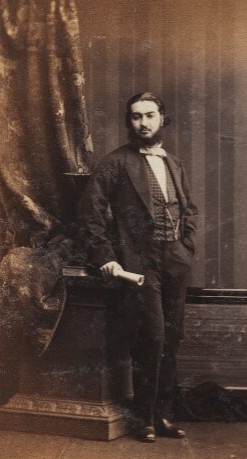
Demetrius Stefanovich Schilizzi was an Ottoman-born Greek banker in London and Paris, and later a steamship owner in Constantinople. He was also the acting Italian consul in Calcutta for some time starting in 1864, and an amateur composer.

Abu Naddara was an Arabic political satire magazine based in Cairo, Egypt, and then in Paris, France. Its title, Abu Naddara, was the pseudonym of the founder, Yaqub Sanu. The magazine was the first Arabic publication which employed cartoons to express social and political criticism. It existed in the period 1877–1910.
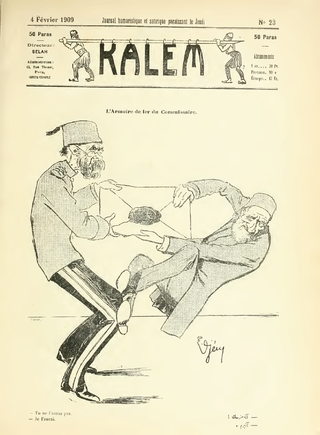
Kalem was a bilingual weekly political satire magazine which was in circulation in the period 1908–1911 in Istanbul, Ottoman Empire. The magazine was one of the satirical publications which were started immediately after the end of Ottoman Sultan Abdulhamid's strict rule. It was published in Turkish and French languages and was one of the most notable satirical magazines in the Empire in terms of the quality cartoons. In addition, it is the first Ottoman publication which employed the word cartoon and attempted to develop a definition for it.
Diken was a weekly satirical magazine which was published in the period 1918–1920 in Istanbul, Ottoman Empire. It was one of the publications which were founded by Sedat Simavi, a well-known Turkish journalist. The magazine was one of the first Ottoman satirical publications which featured color cartoons.
Hanımlara Mahsus Gazete was an Ottoman women's magazine which was published in Istanbul from 1895 to 1908. It was one of the long-term publications in the Ottoman Empire which shaped the literary traditions of the Ottoman women. However, due to the intensive censorship during the reign of Sultan Abdulhamit the magazine mostly featured conventional topics.
References
- 1 2 3 4 5 6 Volkan Kahyalar (19 March 2023). "Gazeteci Teodor Kasap'ın inanılmaz ama gerçek hikâyesi". Journo (in Turkish). Retrieved 14 June 2023.
- 1 2 3 4 Aslı Tunç. Beyond the line: The situation of editorial cartoonists as a press freedom issue in post-1980 Turkey (PhD thesis). Temple University. p. 60. ProQuest 304630926.
- 1 2 Efrat E. Aviv (2013). "Cartoons in Turkey – From Abdülhamid to Erdoğan". Middle Eastern Studies . 49 (2): 223. doi:10.1080/00263206.2012.759101.
- ↑ Furkan Bayrak (December 2019). "İlk Türkçe Karikatür Mizah Dergilerimiz". Yeni Ufuk Dergisi (in Turkish). Retrieved 14 June 2023.